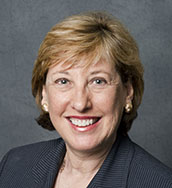KU wins grant to produce data-driven news for community media companies

LAWRENCE — University of Kansas journalism students are partnering with working professionals to build a data-driven, crowdsourced, locally focused model of presenting business news and information that can potentially be used by small news organizations across the country.
 With a $35,000 grant from the Online News Association, the William Allen White School of Journalism & Mass Communications is working with the Lawrence Journal-World to build a framework to gather data and present community business and economic data in easily digestible ways.
With a $35,000 grant from the Online News Association, the William Allen White School of Journalism & Mass Communications is working with the Lawrence Journal-World to build a framework to gather data and present community business and economic data in easily digestible ways.
Pam Fine, Knight Chair in News, Leadership and Community at KU and principal investigator of the grant, said the project, known as DataSmart Lawrence, has three major goals:
- Create data templates and data presentation tools for regularly produced Town Talk business-related reports
- Develop a data channel, or more advanced way of telling data-based, business-related stories
- Develop and measure ways to increase sharing of business and economic data by readers for use in the column.
The grant was part of a $1 million challenge fund by the Online News Association to “hack the curriculum” in journalism schools, or find new ways to put the curriculum to use for community news organizations. The project will continue through the end of the spring semester, and winners will have the opportunity to apply for $100,000 in grant funding to further their projects. The project is administered by the Online News Association with support from Excellence and Ethics in Journalism Foundation, the Robert R. McCormick Foundation, Knight Foundation, the Democracy Fund, Rita Allen Foundation and the Scripps Howard Foundation.
“Our idea was to create a win-win situation where we could improve student learning through data visualization, as well as create a community business information repository for the Journal-World and its readers,” Fine said.
The school’s curriculum offers students a data visualization and reporting class in which they learn how to take large amounts of complex information, find out what stories that data can tell and present it in visually appealing, useful ways, such as charts, graphs and maps. The Journal World’s popular Town Talk column, produced by editor Chad Lawhorn, regularly features lists comparing Lawrence to other cities on a variety of measures including sales tax, job growth and new home construction. Students will work with databases Lawhorn already uses to prepare templates the paper can use to present the information in graphic form. The students will also do their own analysis on those and other databases to identify and produce other data-driven visualizations and stories of interest to readers.
The focus on business and economic data is the first step by the partners to build content for a visually engaging, digital data channel where readers can go to find community and demographic information related to a variety of topics including health, education, public safety and more.
“The data channel will be a repository that can pull useful information community members would be interested in seeing into a single, easy to access, interesting place,” Fine said. “There are many places where there this type of information is available now, but they’re all in disparate locations.”
The project will also develop and measure ways for readers to contribute ideas for information they’d like to see reporting on and where that data can be found. Those will include social media, commenting on the column, focus groups and newly developed methods.
“There are health, real estate professionals, small business owners and many others in the community whose business decisions are driven by data,” Fine said. “We’ll be asking them, ‘Is there data you use that you think the Journal-World should access and share with the community?’”
Fine is partnering with Hyunjin Seo and Mike Williams, associate professors of journalism; Lawhorn; Scott Stanford, Lawrence Journal-World publisher, and three student project assistants. Seo is leading the research into the effectiveness of crowdsourcing messages. Williams is leading the class that will develop graphic templates for business data. If the project is successful, it could potentially be replicated at news organizations throughout the country.
“The hope is to be able to help other small news organizations use crowdsourcing techniques to get people in the community to share interesting data sets with the organization and help make them available to more of their readers,” Fine said.